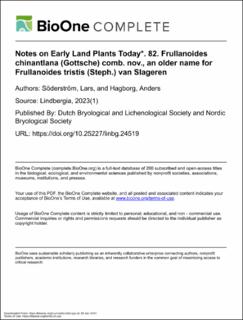Notes on Early Land Plants Today. 82. Frullanoides chinantlana (Gottsche) comb. nov., an older name for Frullanoides tristis (Steph.) van Slageren
Peer reviewed, Journal article
Published version
Permanent lenke
https://hdl.handle.net/11250/3113523Utgivelsesdato
2023Metadata
Vis full innførselSamlinger
- Institutt for biologi [2514]
- Publikasjoner fra CRIStin - NTNU [37221]
Originalversjon
10.25227/linbg.24519Sammendrag
Frullanoides tristis (Steph.) van Slageren is a well-established taxon and the name has been used frequently since the revision of the genus by van Slageren (1985). But there is a nomenclature problem with the name as van Slageren (op. cit.) used Lejeunea (subg. Brachiolejeunea) tristis Steph., Hedwigia 29(1): 8, 29(3): 134, 1890, as basionym. However, as Söderström et al. (2015) showed, it is unclear if Stephani (1890a, b) recognized Spruce's subgenera as genera or not at that point and Söderström et al. (2016) proposed to place the publication in the list of suppressed works (ICN2018 Art. 34 and Appendix VI; Turland et al. 2018). It is thus to be regarded as an invalid name. Stephani (1912) used the name Brachiolejeunea tristis clearly pointing back on his 1890 treatment, and thus validated the name.
Phragmicoma bicolor γ chinantlana was described by Gottsche (1863) and first combined at species level as Brachiolejeunea chinantlana (Gottsche) Schiffn. by Schiffner (1894). Thus, it is the oldest name at species level. This taxon was synonymized with Frullanoides tristis by van Slageren (1985) which he due to using the old invalid basionym, used as the oldest name and combined it in Frullanoides. However, as ‘chinantlana’ is an older name and lacking combination in Frullanoides a new combination is needed.

